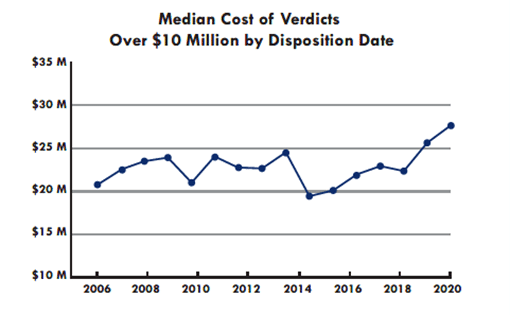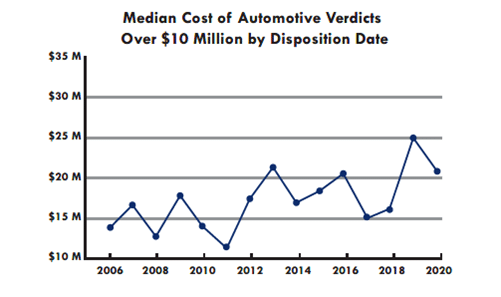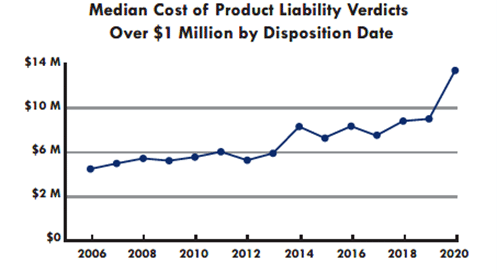Socially Inflated Jury Verdicts, Plaintiff’s Efforts to Attain the Nuclear Verdict, and Defense Strategies in Combating It
Social Inflation – What is it?
- A term used to describe increased loss costs stemming from claims far more severe than what could be anticipated under the usual scope of economic inflation and claims trends.
- When insurance coverage becomes more expensive because of external and evolving changes in the market.
- It is thought to be the result of litigation funding, an erosion of tort reform, negative public sentiments toward large businesses and corporations, and jury desensitization to large awards.
Social Inflation – What causes it?
- Can be traced back to the 2008 financial crisis and centers on litigation.
- There are three major drivers of social inflation in the past decade: (1) Distrust of big business; (2) Increased litigation; and (3) Massive verdicts.
Distrust of big business
- From policy to public sentiment, society’s general disdain for large corporations fuels more than social media rants. It impacts can be seen everywhere from jury verdicts to rollbacks of tort reforms.
- When jurors blame problems in the economy and income inequality on big businesses, they tend to side against companies and award larger claims to plaintiffs. Large-scale data beaches, highly publicized mergers, and political movements all contribute to anti-corporate sentiment.
- Many states enacted tort reforms in past decades to reduce frivolous litigation and cap settlements – but these reforms are going away.
- The result is a climate that makes it easier to sue companies and win large settlements, thereby driving up the costs of claims and coverage.
Increased litigation
Another impactful trend is litigation funding.
- In the past, high attorney fees deterred plaintiffs from pursuing trials.
- Today, third parties can recover the costs of litigation in exchange for receiving a portion of the settlement.
- Litigation funding leads to more lawsuit that go further and last longer.
Massive verdicts
- All of this adds up to the normalization of huge financial awards by juries.
- As juries decide to hold businesses accountable and cultural sentiment assumes big corporations can afford anything, multimillion-or even multibillion—dollar verdicts have become usual and expected.
Corporate Disdain
- Corporations value profits over people and the courtroom is a “tool” for the people to stand up to corporations.
- The “Great Resignation” is an example that corporations prefer profits over paying their employees a higher wage.
Impacts of Social Inflation[i]
- From 2015 to 2020, the median cost of a jury award over $10 million increased by 35%, from $20 million to $27 million.
- A jury award of more than $10 million is considered a “nuclear verdict” within the insurance industry.
- The median cost of awards over $10 million remained in the low- to mid- $20 million range from 2005-18, before rising in 2019-2020.

Commercial auto trends
- Jury verdicts for commercial auto losses over $10 million showed a gradual increase from 2010 to 2013 – with a low of $12 million and a high of $22 million – before rising dramatically in 2019.
- Nuclear verdicts are of primary concern for transportation companies and a factor in insurance rages.

Product liability trends
- Product liability verdicts have also been increasing.
- The median cost of product liability verdicts over $1 million rose steadily from 2006 to 2019, with a sharp jump in severity in 2020 to pass the nuclear verdict threshold.

COVID-19
What impact does COVID-19 have on social inflation?
- Some experts believe negative sentiments expressed toward insurers over pandemic-related coverage could lead to increasingly severe verdicts.
- Others believe the job opportunities presented by large corporations will lessens the negative sentiments expressed toward them by juries in the aftermath of a COVID-19 related recession.
Recent Verdicts in Arkansas and Texas
Arkansas
St. Francis County 75 Million-dollar verdict
- Facts: Tractor Trailer was hauling Formic Acid and collided with a pickup truck, causing the tractor trailer to turn on its side and catch fire. First responders arrive on the scene and call freight company and ask if there are any hazardous materials on board and are told “no”. After putting out the fire for 5 hours, they receive an email from the Freight company informing them that there was hazardous material on board. Plaintiff’s breathed in toxic fumes from the acid burning and suffered permanent lung damage.
- Venue: St. Francis County
- Plaintiffs: State troopers, Sherriff’s department, fire fighters, tow truck employees
- A few of the Appeals pending:
- Order denying Motion to exclude Plaintiff’s expert testimony
- Order denying bifurcated trial
- Denying issue of “professional rescuer’s doctrine”
- Denying directed verdict on toxic tort causation
Texas
Dram Shop Verdict- $301 Billion
- The bar was accused of overserving a customer who ended up driving intoxicated, running a red light, and killing 2 people in a motor vehicle accident.
- The Plaintiff’s attorneys admitted they don’t expect to see a single dollar.
- The Bar is no longer open and did not have insurance.
- From the pleadings it appears that the Bar’s attorney withdrew, a Motion for Directed Verdict was entered and there was only a jury trial on damages with no defense.
- The news coverage of this verdict desensitizes future jurors to nuclear verdicts.
Plaintiff’s Formula for a Nuclear Verdict
A problem witness is the Number 1 factor leading to a nuclear verdict.
- Reptile questioning in deposition.
- Ineffective defense strategies at the deposition
- Emotional meltdown.
- Strategy deviation.
- Witnesses have to listen and think.
- Other factors:
- Egregious conduct of Defendants – now the jurors are awarding for punitive behavior, not based on compensatory issues.
- Plaintiff attorney aggressiveness / defense attorney conservatism.
- Mock trials and focus groups to find the ideal juror.
- Cynical, resentful, and negative jurors that lie in voir dire.
- Plaintiff makes excessive demand, refuses to settle, and plays the odds at trial.
- Judicial hellholes – bad venue.
Defending Against the Nuclear Verdict
- Professional deposition preparation.
- Mock jury research and mock trial / focus group.
- Juror profiling.
- Identify problems early.
- Aggressive advocacy.
- Discovery responses, requests, and motions.
- Expert selection.
- Visual aids and animations.
- Mediation strategy.
- Trial preparation.
- Anchoring.
- Admitting liability.
- Be thinking of appeal issues.
- Picking the right Rule 30(b)(6) witness.
- The “right” Rule 30(b)(6) may not be the person with the most knowledge on the topics of the deposition. You can always educate the witness.
- Counter Corporate Mistrust
- Corporations often enter a jury case at a significant disadvantage because of growing negative sentiment about large corporations. According to a recent survey, less than half of people trust large companies, and another survey found that more than 30 percent of jurors have negative views of corporations.[ii]
- Humanize the Company. Highlight:
- How does the company benefit the community
- How does it help employees
- Charitable causes
[i] See “In the Know: Social Inflation and Increasing Cost of Large Jury Awards” produced by VGM Insurance Services.
[ii] See https://www.axios.com/mistrust-us-business-2020-grows-fae6474c-8406-4ae2-999f-9279aa849703.html.
